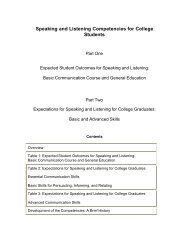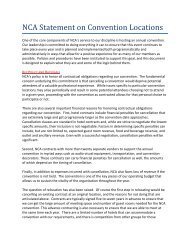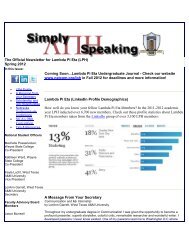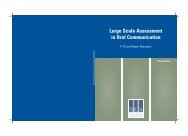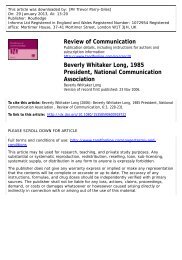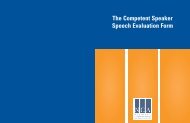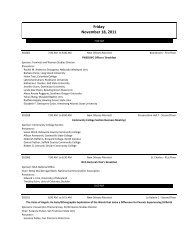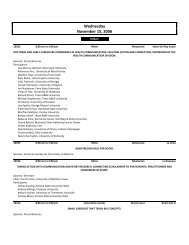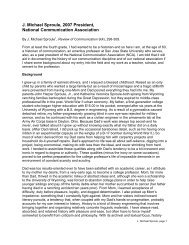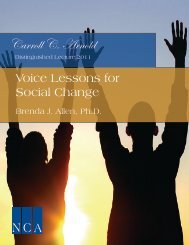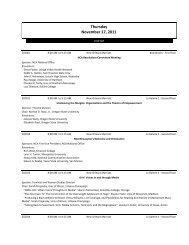skills.” CAT has been one of the most active, consistent,and productive of NCA’s various committees and taskforces.Under the guidance of CAT, NCA has published severalvolumes exploring formal methods for assessingoral communication. These publications began <strong>to</strong> appearin the 1970s and have continued in<strong>to</strong> the 1990s. In 1978,for example, the <strong>National</strong> <strong>Communication</strong> Associationpublished <strong>Assessing</strong> Functional <strong>Communication</strong>, whichwas followed in 1984 by two other major publications,Large Scale Assessment of Oral <strong>Communication</strong> Skills:Kindergarten through Grade 12 and Oral <strong>Communication</strong>Assessment Procedures and Instrument Developmentin Higher Education.In 1979, in Standards for Effective Oral <strong>Communication</strong>Programs, NCA adopted its first set of “standards”for “assessment and evaluation.” The first standardscalled for “school-wide assessment of speaking and listeningneeds of students,” “qualified personnel” <strong>to</strong> “utilizeappropriate evaluation <strong>to</strong>ols,” a “variety of data”and “instruments” which “encourage” “students’ desire<strong>to</strong> communicate.”In 1986, in Criteria for Evaluating Instruments andProcedures for <strong>Assessing</strong> Speaking and Listening, NCAadopted an additional 15 “content” and “technical considerations”dealing “primarily with the substance ofspeaking and listening instruments” and “matters suchas reliability, validity and information on administration.”These criteria included the importance of focusingon “demonstrated” speaking skills rather than “readingand writing ability,” adopting “assessment instrumentsand procedures” which are “free of sexual, cultural, racial,and ethnic content and/or stereotyping,” employing“familiar situations” which are “important for variouscommunication settings” in test questions, using instrumentswhich “permit a range of acceptable responses”and generate “reliable” outcomes, employing assessmentswhich are consistent with other “results” andhave “content validity,” and employing “standardized”procedures which “approximate the recognized stresslevel of oral communication” which are also “practicalin terms of cost and time” and “suitable for the developmentallevel of the individual being tested.”In 1987, at the NCA Wingspread Conference, “conferenceparticipants recommended that the chosen instrumentconform <strong>to</strong> NCA guidelines for assessmentinstrument,” and they specifically suggested that “strategiesfor assessing speaking skills” should be directlylinked <strong>to</strong> the content of oral communication performancesand student speaking competencies. Prescribedcommunication practices were <strong>to</strong> determine the choiceof assessment strategies, with the following contentstandards guiding formal evaluations: “determine thepurpose of oral discourse;” “choose a <strong>to</strong>pic and restrictit according <strong>to</strong> the purpose and the audience;” “fulfillthe purpose” by “formulating a thesis statement,” “providingadequate support material,” “selecting a suitableorganization,” “demonstrating careful choice of words,”“providing effective transitions,” “demonstrating suitableinter-personal skills;” employing “vocal-variety inrate, pitch, and intensity;” “articulate clearly;” “employthe level of American English appropriate <strong>to</strong> the designatedaudience;” and “demonstrate nonverbal behaviorthat supports the verbal message.” Additionally, theWingspread Conference participants considered strategiesfor assessing listening and for training assessors[see: <strong>Communication</strong> Is Life: Essential College SophomoreSpeaking and Listening Competencies (Washing<strong>to</strong>n,D.C.: <strong>National</strong> <strong>Communication</strong> Association, 1990,pp. 51-74).In 1988, the NCA Flagstaff Conference generated aseries of resolutions calling for a “national conference”and “task force on assessment” because “previous experiencein developing standardized assessment has metwith problems of validity, reliability, feasibility, ethics,and cultural bias” [in The Future of Speech <strong>Communication</strong>Education: Proceedings of the 1988 <strong>National</strong><strong>Communication</strong> Association Flagstaff Conference, ed.by Pamela J. Cooper and Kathleen M. Galvin (Annandale,VA: <strong>National</strong> <strong>Communication</strong> Association, 1989,p. 80)].In July 1990, a <strong>National</strong> Conference on Assessmentwas sponsored by NCA, the NCA Committee on Assessmentand Testing or CAT, and the NCA EducationalPolicies Board (EPB). The conference generated severalresolutions regarding assessment.* Some of theseresolutions reaffirm existing NCA oral communicationassessment policies. Others provide criteria for resolvingnew issues in assessment. Still others seek <strong>to</strong> integrateand establish a more coherent relationship among*The criteria contained in this document were originally adopted asresolutions at the NCA Conference on Assessment in Denver, Colorado,in July 1990. Several of the criteria were authored by the Committeeon Assessment and Testing Subcommittee on Criteria for Content,Procedures, and Guidelines for Oral <strong>Communication</strong> Competenciescomposed of James W. Crocker-Lakness (Subcommittee Chair),Sandra Manheimer, and Tom E. Scott. The introduction sections,entitled “A <strong>National</strong> Context” and “NCA’s Assessment Activities,”were authored by James W. Chesebro, NCA Direc<strong>to</strong>r of EducationServices.<strong>Assessing</strong> <strong>Motivation</strong> <strong>to</strong> <strong>Communicate</strong> 25
the criteria governing oral communication assessment.The recommended assessment criteria are detailed onthe next page.General Criteria1. Assessment of oral communication should viewcompetence in oral communication as a gestal<strong>to</strong>f several interacting dimensions. At a minimum,all assessments of oral communicationshould include an assessment of knowledge(understanding communication process, comprehensionof the elements, rules, and dynamicsof a communication event, awareness of whatis appropriate in a communication situation),an assessment of skills (the possession of a reper<strong>to</strong>ireof skills and the actual performance ofskills), and an evaluation of the individual’s attitude<strong>to</strong>ward communication (e.g., value placedon oral communication, apprehension, reticence,willingness <strong>to</strong> communicate, readiness <strong>to</strong> communicate).2. Because oral communication is an interactiveand social process, assessment should considerthe judgment of a trained assessor as well as theimpressions of others involved in the communicationact (audience, interviewer, other groupmembers, conversant), and may include the selfreport of the individual being assessed.3. Assessment of oral communication shouldclearly distinguish speaking and listening fromreading and writing. While some parts of the assessmentprocess may include reading and writing,a major portion of the assessment of oralcommunication should require speaking andlistening. Directions from the assessor and responsesby the individual being assessed shouldbe in the oral/aural mode.4. Assessment of oral communication should besensitive <strong>to</strong> the effects of relevant physical andpsychological disabilities on the assessment ofcompetence. (e.g., with appropriate aids in signalreception, a hearing impaired person can bea competent empathic listener.)5. Assessment of oral communication should bebased in art on a<strong>to</strong>mistic/analytic data collectedand on a holistic impression.Criteria for the Content of Assessment6. Assessment of oral communication for all studentsshould include assessment of both verbaland non-verbal aspects of communication andshould consider competence in more than onecommunication setting. As a minimum assessmentshould occur in the one-<strong>to</strong>-many setting(e.g. public s peaking, practical small groupdiscussion) and in the one-<strong>to</strong>-one setting (e.g.,interviews, interpersonal relations).7. Assessment of speech majors and other oral communicationspecialists could include in additionassessment in specialized fields appropriate <strong>to</strong>the course of study followed or the specialty ofthe person being assessed.Criteria for Assessment Instruments8. The method of assessment should be consistentwith the dimension of oral communication beingassessed. While knowledge and attitude may beassessed in part through paper and pencil instruments,speaking and listening skills must be assessedthrough actual performance in social settings(speaking before an audience, undergoingan interview, participating in a group discussion,etc.) appropriate <strong>to</strong> the skill(s) being assessed.9. Instruments for assessing oral communicationshould describe degrees of competence. Either/or descriptions such as “competent “or “incompetent”should be avoided as should attempts <strong>to</strong>diagnose reasons why individuals demonstrateor fail <strong>to</strong> demonstrate particular degrees of competence.10. Instruments for assessing each dimension of oralcommunication competence should clearly identifythe range of responses which constitute variousdegrees of competence. Exam les of suchresponses should be provided as anchors11. Assessment instruments should have an acceptablelevel of reliability, e.g. test /retest reliability,split-half reliability, alternative forms reliability,inter-rater reliability, and internal consistency.12. Assessment instruments should have appropriatevalidity: content validity, predictive validity, andconcurrent validity.13. Assessment instruments must meet acceptablestandards for freedom from cultural, sexual, ethical,racial, age, and developmental bias.14. Assessment instruments should be suitable forthe developmental level of the individual beingassessed.15. Assessment instruments should be standardizedand detailed enough so that individual responses26 <strong>Assessing</strong> <strong>Motivation</strong> <strong>to</strong> <strong>Communicate</strong>




